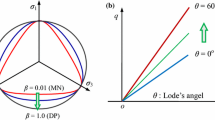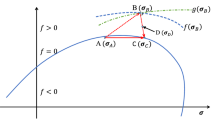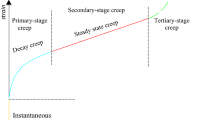Abstract
A reasonable prediction of the elastic modulus of rock and rock mass can provide sound basis for the design in tunnels and underground caverns. It is observed from the laboratory results that the elastic modulus not only depends on the confining pressure but also indicates certain sensitivity to the failure degree during the loading-fracturing process. This paper deduces a unified expression for the elastic modulus with the coupling effects of the plastic strain and confining stress, and fits the soft, moderate, hard rocks with different quality. In this paper, a method to determine the elastic modulus from the laboratory results is proposed. Through the method, the variation of the elastic modulus versus the plastic strain and confining stress for the soft, moderate, hard rocks is analysed. A unified deterioration model for the elastic modulus is developed by the nonlinear fitting regression method. This deterioration model can be employed in the analytical and numerical analysis of the tunnels and underground caverns, which enables to present a more realistic mechanical behaviour of rock mass.
Highlights
-
Variation of elastic modulus versus plastic strain and confining stress for soft, moderate, hard rocks is analysed.
-
A unified deterioration model for elastic modulus is developed by nonlinear fitting regression method.
-
This deterioration model can be employed in analytical and numerical analysis of tunnels and underground caverns.









Similar content being viewed by others
References
Arzua Touriño J (2015) Study of the mechanical behavior of intact and jointed rocks in laboratory with particular emphasis on dilatancy. Dissertation, Universidade de Vigo
Alejano LR, Rodriguez-Dono A, Alonso E, Fdez-Manín G (2009) Ground reaction curves for tunnels excavated in different quality rock masses showing several types of post-failure behaviour. Tunn Undergr Space Technol 24(6):689–705
Arslan AT, Koca MY, Aydogmus T, Klapperich H, Yılmaz HR (2008) Correlation of unconfined compressive strength with Young’s modulus and poisson’s ratio in gypsum from Sivas (Turkey). Rock Mech Rock Eng 41(6):941–950
Asef MR, Reddish DJ (2002) The impact of confining stress on the rock mass deformation modulus. Geotechnique 52(4):235–241
Brown ET, Bray JW, Santarelli FJ (1989) Influence of stress-dependent elastic moduli on stresses and strains around axisymmetric boreholes. Rock Mech Rock Eng 22(3):189–203
Cai M, Kaiser PK, Tasaka Y, Minami M (2007) Determination of residual strength parameters of jointed rock mass using the GSI system. Int J Rock Mech Min Sci 44(2):247–265
Crouch SL (1970) Experimental determination of volumetric strain in failed rock. Int J Rock Mech Min Sci 7(6):589–603
Cui L, Zheng JJ, Zhang RJ, Dong YK (2015a) Elasto-plastic analysis of a circular opening in rock mass with confining stress-dependent strain-softening behaviour. Tunn Undergr Space Technol 50:94–108
Cui L, Zheng JJ, Zhang RJ (2015b) Lai HJ (2015)A numerical procedure for the fictitious support pressure in the application of the convergence–confinement method for circular tunnel design. Int J Rock Mech Min Sci 78:336–349
Cui L, Sheng Q, Zheng JJ, Cui Z, Wang A, Shen Q (2019a) Regression model for predicting tunnel strain in strain-softening rock mass for underground openings. Int J Rock Mech Min Sci 119:81–97
Cui L, Zheng JJ, Sheng Q, Pan Y (2019b) A simplified procedure for the interaction between fully-grouted bolts and rock mass for circular tunnels. Comput Geotech 106:177–192
Cui L, Sheng Q, Dong YK, Xie MX (2022) Unified elasto-plastic analysis of rock mass supported with fully grouted bolts for deep tunnels. Int J Numer Anal Methods Geomech 2022:1–25
Diederichs MS, Martin CD (2010) Measurement of spalling parameters from laboratory testing. In: Proceedings of Eurock 2010, Lausanne
Elliot GM, Brown ET (1985) Yield of a soft, high porosity rock. Geotechnique 35(4):413–423
Farmer IW (1983) Engineering behaviour of rocks, 2nd edn. Chapman and Hall, London
Hadizadeh J, Rutter EH (1983) The low temperature brittle–ductile transition in quartzite and occurrence of cataclastic flow in nature. Geol Rundsch 72(2):493–503
Hoek E, Kaiser PK, Bawden WF (1997) Support of underground excavations in hard rock. Balkema, Rotterdam
Hsieh A, Dyskin AV, Dight P (2014) The increase in Young’s modulus of rocks under uniaxial compression. Int J Rock Mech Min Sci 70:425–434
Huang F, Cao Z, Jiang SH, Zhou C, Huang J, Guo Z (2020) Landslide susceptibility prediction based on a semi-supervised multiple-layer perceptron model. Landslides 17(12):2919–2930
Hudson JA, Harrison JP (1997) Engineering rock mechanics—an introduction to the principles. Pergamon Press, Oxford
Karman TV (1911) Festigkeitsversuche unter allseitigem druck. Zeitschr Verh Dtsch Ing 55:1749–1757
Lv A, Ramandi HL, Masoumi H, Saadatfar M, Regenauer-Lieb K, Rosan H (2019) Analytical and experimental investigation of pore pressure induced strain softening around boreholes. Int J Rock Mech Min Sci 113:1–10
Martin CD, Chandler NA (1994) The progressive fracture of Lac du Bonnet Granite. Int J Rock Mech Min Sci Geomech Abstr 31(6):643–659
Medhurst TP (1996) Estimation of the in-situ strength and deformation of coal for engineering design. Dissertation, University of Queensland
Szwilski AB, Brawner CO (1984) Stability in underground mining II. United States
Wu XZ, Jiang YJ, Guan ZC, Wang G (2018) Estimating the support effect of energy-absorbing rock bolts based on the mechanical work transfer ability. Int J Rock Mech Min Sci 103:168–178
Wu XZ, Jiang YJ, Guan ZC, Gong B (2019) Influence of confining pressure-dependent Young’s modulus on the convergence of underground excavation. Tunn Undergr Space Technol 83:135–144
Yang FJ, Zhou H, Xiao HB, Zhang CQ, Zhang K, Yang YS (2013) Research on confining pressure effect of elastic parameters of marble and its elasto-plastic coupling model (in Chinese). Rock Soil Mech 34(6):1614–1620
Yang JP, Chen WZ, Yang DS, Tian HM (2016) Estimation of elastic moduli of non-persistent fractured rock masses. Rock Mech Rock Eng 49(5):1977–1983
You MQ (2003) Effect of confining pressure on the Young’s modulus of rock specimen and the friction in fissures (in Chinese). Rock Soil Mech 24(S2):167–170
Zhang C, Zhao J, Zhang Q, Hu X (2012) A new closed-form solution for circular openings modeled by the unified strength theory and radius-dependent Young’s modulus. Comput Geotech 42:118–128
Zhang Q, Zhang C, Jiang B, Li N, Wang Y (2018) Elastoplastic coupling solution of circular openings in strain-softening rock mass considering pressure-dependent effect. Int J Geomech 18(1):04017132
Zhao XG, Li PF, Ma LK, Su R, Wang J (2014) Damage and dilation characteristics of deep granite at Beishan under cyclic loading unloading conditions (in Chinese). Chin J Rock Mech Eng 33(9):1740–1748
Zhou H, Zhang K, Feng XT, Shao JF, Qiu SL (2010) Elastoplastic coupling mechanical model for brittle marble (in Chinese). Chin J Rock Mech Eng 29(12):2398–2409
Acknowledgements
The authors acknowledge the experimental results of the rocks that provided by Professor L R Alejano from Vigo University, and the financial support provided by National Natural Science Foundation of China (Grant no. 52009129, no. U21A20159).
Author information
Authors and Affiliations
Corresponding author
Additional information
Publisher's Note
Springer Nature remains neutral with regard to jurisdictional claims in published maps and institutional affiliations.
Rights and permissions
Springer Nature or its licensor holds exclusive rights to this article under a publishing agreement with the author(s) or other rightsholder(s); author self-archiving of the accepted manuscript version of this article is solely governed by the terms of such publishing agreement and applicable law.
About this article
Cite this article
Cui, L., Sheng, Q., Zheng, J. et al. A Unified Deterioration Model for Elastic Modulus of Rocks with Coupling Influence of Plastic Shear Strain and Confining Stress. Rock Mech Rock Eng 55, 7409–7420 (2022). https://doi.org/10.1007/s00603-022-03000-9
Received:
Accepted:
Published:
Issue Date:
DOI: https://doi.org/10.1007/s00603-022-03000-9




